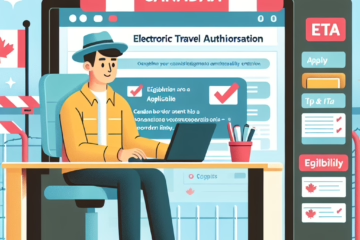Canada’s Intra-Company Transferee (ICT) Program is a vital component of the International Mobility Program, designed to facilitate the temporary transfer of employees within multinational companies. This program aims to enhance Canadian interests by allowing skilled foreign workers to bring their expertise to Canadian operations. Understanding the qualifications and benefits of the ICT program is crucial for businesses and employees considering this pathway. This article delves into the intricacies of the ICT program, including eligibility criteria, qualifying relationships, and the benefits under R205(a).
Table of contents
Overview of Canada’s Intra-Company Transferee Program
Canada’s Intra-Company Transferee (ICT) Program is an essential part of the International Mobility Program, which allows multinational companies to transfer key employees to their Canadian counterparts. This program is designed to enable the seamless movement of skilled workers, such as executives, managers, and specialists, who possess vital knowledge and expertise. By facilitating these transfers, the ICT program helps Canadian businesses gain a competitive edge in the global market.
The ICT program is governed by the regulations set forth in R205(a) of the Immigration and Refugee Protection Regulations (IRPR), which permits work without the need for a Labour Market Impact Assessment (LMIA). This exemption is based on the significant benefits these transfers bring to Canada, such as fostering innovation, enhancing productivity, and contributing to overall economic growth.
Both the employee and the employer must meet specific requirements to participate in the ICT program. These requirements ensure that only qualified individuals who can genuinely contribute to the Canadian economy are granted entry. Understanding these qualifications is key to a successful application process.
The ICT program benefits the Canadian economy and supports the growth and global integration of the participating companies. By allowing the transfer of essential personnel, businesses can ensure consistency in their operations and leverage their international workforce’s unique skills and knowledge.
Eligibility Criteria
Eligibility for the Intra-Company Transferee program hinges on several critical criteria the employee and the employer must satisfy. Firstly, the employee must have been employed continuously by the multinational company in a similar full-time position for at least one year in the three years preceding the application. This employment period is crucial to verifying the employee’s experience and commitment to the company.
The role that the employee intends to fill in Canada must be either an executive, senior managerial, or specialized knowledge position. Executives primarily direct the management of the company or a significant component of it. Senior managers manage the organization or a department, supervising other managers or professionals. Specialized knowledge workers possess advanced expertise or unique knowledge critical to the company’s operations.
It is also essential that the employee’s role in Canada is consistent with the company’s objectives and operations. The job must align with the business’s strategic goals and contribute to its growth and success. The company must demonstrate that the transfer will significantly benefit Canada, aligning with the requirements under R205(a).
Additionally, the employee must have the necessary qualifications and credentials to perform the duties of the intended position in Canada. This includes relevant educational background, professional certifications, and other qualifications required for the role. Meeting these eligibility criteria ensures that the transferred employee can effectively contribute to the Canadian entity’s success.
Understanding Qualifying Relationships
A crucial aspect of the ICT program is the qualifying relationship between the Canadian entity and the foreign company. The relationship must be one of the following: parent, branch, subsidiary, or affiliate. This ensures that the transfer is legitimate and serves the multinational company’s business interests. The entities involved must provide substantial evidence of their qualifying relationship to meet the program’s requirements.
A parent company owns a majority interest in another company, known as a subsidiary. A branch is an operating division or office of the same company situated in a different location. Subsidiaries are companies in which the parent company owns more than 50% of the voting shares. Affiliates are two entities owned and controlled by the same parent company or individual, maintaining significant control and ownership.
Companies must provide documentation such as corporate records, financial statements, and organizational charts to substantiate the qualifying relationship. These documents help immigration officers verify the relationship’s legitimacy and ensure compliance with the program’s guidelines. Clear and accurate documentation is critical to a successful ICT application.
The qualifying relationship must also be continuous and ongoing. This means that the relationship must have existed for a significant period before the application and continued during the employee’s tenure in Canada. This continuity ensures that the transfer is part of a genuine business strategy rather than a temporary arrangement to circumvent immigration rules.
Benefits and Canadian Interests Under R205(a)
The benefits of the ICT program under R205(a) extend beyond the individual companies and contribute significantly to Canadian interests. By allowing the transfer of key personnel, the program fosters innovation and knowledge transfer, driving economic growth and competitiveness. The expertise brought by intra-company transferees can lead to developing new products, services, and processes, enhancing Canada’s position in the global market.
One of the primary advantages of the ICT program is the exemption from the Labour Market Impact Assessment (LMIA). This exemption simplifies the process for companies and expedites the transfer of essential personnel. The LMIA exemption is granted based on the significant benefit the transferred employees bring to Canada, aligning with the country’s economic and strategic goals.
Intra-company transferees often contribute to the training and development of Canadian employees, sharing their specialized knowledge and skills. This knowledge transfer can enhance the capabilities of the local workforce, fostering a culture of continuous improvement and innovation. Canadian companies can improve their productivity and operational efficiency by integrating international expertise.
Moreover, the ICT program supports the global integration of Canadian businesses, enabling them to maintain consistency in their operations across different locations. This global integration is vital for businesses looking to expand their reach and compete in the international market. By facilitating the movement of key personnel, the ICT program helps Canadian companies achieve their strategic objectives and contribute to the country’s economic prosperity.
Understanding the qualifications for Canada’s Intra-Company Transferee Program is essential for multinational companies and their employees. By meeting the eligibility criteria and demonstrating a qualifying relationship, businesses can leverage the benefits of the ICT program to enhance their operations in Canada. The program supports the growth of individual companies and contributes to broader Canadian interests by fostering innovation, economic growth, and global integration. Whether you are an employer looking to transfer key personnel or an employee seeking to bring your expertise to Canada, the ICT program offers a valuable pathway to achieve your goals.
Frequently Asked Questions
The ICT Program allows multinational companies to transfer key employees to their Canadian counterparts, enhancing Canadian interests by bringing in skilled foreign workers who possess vital expertise.
The ICT Program is governed by R205(a) of the Immigration and Refugee Protection Regulations (IRPR).
The LMIA exemption simplifies the transfer process by eliminating the need for companies to prove that hiring a foreign worker will not negatively impact the Canadian labor market, as the transfer itself is deemed to significantly benefit Canada.
Eligible employees include executives, senior managers, and specialized knowledge workers who have been employed continuously by the multinational company in a similar full-time position for at least one year in the three years preceding the application.
Qualifying roles include executive positions, senior managerial roles, and specialized knowledge positions critical to the company’s operations.
The employee must have the necessary educational background, professional certifications, and other relevant qualifications to perform the duties of the intended position in Canada.
The qualifying relationships include parent, branch, subsidiary, or affiliate relationships.
Companies must provide documentation such as corporate records, financial statements, and organizational charts to substantiate the qualifying relationship.
Continuity ensures that the transfer is part of a genuine business strategy rather than a temporary arrangement to circumvent immigration rules.
The benefits include fostering innovation, enhancing productivity, contributing to economic growth, and supporting the global integration of Canadian businesses.
Intra-company transferees often share their specialized knowledge and skills, which enhances the capabilities of the local workforce and fosters a culture of continuous improvement and innovation.
The employer must be a legitimate multinational company with a qualifying relationship to the Canadian entity and must demonstrate that the transfer significantly benefits Canada.
Specialized knowledge workers must possess advanced expertise or unique knowledge critical to the company’s operations, contributing to the company’s strategic goals in Canada.
By allowing the transfer of essential personnel, the program helps Canadian businesses maintain consistency in their operations, leverage international expertise, and achieve their strategic objectives in the global market.
Executive roles involve directing the management of the company or a significant component of it, often with a high level of decision-making authority.
Senior managerial roles involve managing the organization or a department, typically overseeing other managers or professionals and making critical strategic decisions.
The employee must have been employed continuously for at least one year in a similar full-time position within the three years preceding the application.
Clear and accurate documentation, such as corporate records, financial statements, and organizational charts, is crucial to verifying the qualifying relationship and meeting the program’s guidelines.
The program aligns with Canada’s goals by bringing in skilled workers who can drive innovation, contribute to economic growth, and enhance the competitive edge of Canadian businesses.
The objectives include facilitating the seamless movement of key personnel, ensuring consistency in operations, leveraging unique skills and knowledge, and supporting the company’s growth and integration into the global market.
Have questions regarding Canada Intra-Company Transferee Program (ICT)? Book an appointment with our immigration lawyer.



0 Comments